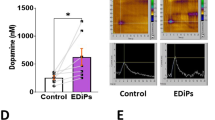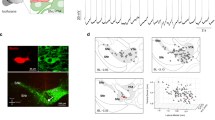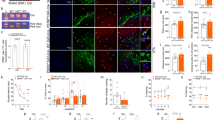Abstract
Aberrant dopamine (DA) signaling has been advanced as a contributing factor to the pathophysiology of a number of psychiatric conditions including schizophrenia; however, the many factors involved in regulating DA system responsivity have not been completely delineated to date. We have shown previously that DA neuron activity states are independently regulated by distinct afferent pathways. We now provide evidence that these pathways interact to control the population of neurons that are phasically activated. As shown previously, infusions of NMDA into the ventral subiculum (vSub) increases the number of spontaneously active DA neurons (population activity), while having no effect on firing rate or average bursting activity. In contrast, NMDA activation of the pedunculopontine tegmental nucleus (PPTg) results in a significant increase in DA neuron burst firing without significantly affecting population activity. However, simultaneous excitation of the vSub and PPTg induces a significant increase in both DA neuron population activity and burst firing resulting in a ∼4-fold increase in the number of high-bursting neurons observed per electrode track. These data suggest that DA neuron population activity is not simply associated with the tonic release of DA in forebrain regions, but rather represents a recruitable pool of DA neurons that can be further modulated by excitatory inputs to induce a graded phasic response. Taken as a whole, we propose that the synchronous activity of distinct afferent inputs to the VTA phasically activates selective populations of DA neurons, and hence may be a site of pathological regulation underlying aberrant DA signaling.
Similar content being viewed by others
Log in or create a free account to read this content
Gain free access to this article, as well as selected content from this journal and more on nature.com
or
References
Berridge KC, Robinson TE (1998). What is the role of dopamine in reward: hedonic impact, reward learning, or incentive salience? Brain Res Rev 28: 309–369.
Blaha CD, Yang CR, Floresco SB, Barr AM, Phillips AG (1997). Stimulation of the ventral subiculum of the hippocampus evokes glutamate receptor-mediated changes in dopamine efflux in the rat nucleus accumbens. Eur J Neurosci 9: 902–911.
Brudzynski SM, Gibson CJ (1997). Release of dopamine in the nucleus accumbens caused by stimulation of the subiculum in freely moving rats. Brain Res Bull 42: 303–308.
Chergui K, Suaud-Chagny MF, Gonon F (1994). Nonlinear relationship between impulse flow, dopamine release and dopamine elimination in the rat brain in vivo. Neuroscience 62: 641–645.
Floresco SB, Todd CL, Grace AA (2001). Glutamatergic afferents from the hippocampus to the nucleus accumbens regulate activity of ventral tegmental area dopamine neurons. J Neurosci 21: 4915–4922.
Floresco SB, West AR, Ash B, Moore H, Grace AA (2003). Afferent modulation of dopamine neuron firing differentially regulates tonic and phasic dopamine transmission. Nat Neurosci 6: 968–973.
Goto Y, Grace AA (2005). Dopaminergic modulation of limbic and cortical drive of nucleus accumbens in goal-directed behavior. Nat Neurosci 8: 805–812.
Grace AA (1991). Phasic versus tonic dopamine release and the modulation of dopamine system responsivity: a hypothesis for the etiology of schizophrenia. Neuroscience 41: 1–24.
Grace AA (2000). Gating of information flow within the limbic system and the pathophysiology of schizophrenia. Brain Res Rev 31: 330–341.
Grace AA, Bunney BS (1983). Intracellular and extracellular electrophysiology of nigral dopaminergic neurons—1. Identification and characterization. Neuroscience 10: 301–315.
Grace AA, Bunney BS (1984). The control of firing pattern in nigral dopamine neurons: burst firing. J Neurosci 4: 2877–2890.
Grunwerg BS, Krein H, Krauthamer GM (1992). Somatosensory input and thalamic projection of pedunculopontine tegmental neurons. Neuroreport 3: 673–675.
Harrison PJ (2004). The hippocampus in schizophrenia: a review of the neuropathological evidence and its pathophysiological implications. Psychopharmacologia 174: 151–162.
Hyland BI, Reynolds JN, Hay J, Perk CG, Miller R (2002). Firing modes of midbrain dopamine cells in the freely moving rat. Neuroscience 114: 475–492.
Kapur S (2003). Psychosis as a state of aberrant salience: a framework linking biology, phenomenology, and pharmacology in schizophrenia. Am J Psychiatry 160: 13–23.
Knight R (1996). Contribution of human hippocampal region to novelty detection. Nature 383: 256–259.
Laruelle M, Abi-Dargham A (1999). Dopamine as the wind of the psychotic fire: new evidence from brain imaging studies. J Psychopharmacol 13: 358–371.
Legault M, Wise RA (1999). Injections of N-methyl-D-aspartate into the ventral hippocampus increase extracellular dopamine in the ventral tegmental area and nucleus accumbens. Synapse 31: 241–249.
Lisman J, Grace AA (2005). The hippocampal–VTA loop: controlling the entry of information into long-term memory. Neuron 46: 703–713.
Lokwan SJA, Overton PG, Berry MS, Clark D (1999). Stimulation of the pedunculopontine tegmental nucleus in the rat produces burst firing in A9 dopaminergic neurons. Neuroscience 92: 245–254.
Pan W-X, Hyland BI (2005). Pedunculopontine tegmental nucleus controls conditioned responses of midbrain dopamine neurons in behaving rats. J Neurosci 25: 4725–4732.
Paxinos G, Watson C (1986). The Rat Brain in Stereotaxic Coordinates. Academic Press: Australia, Sydney.
Reese NB, Garcia-Rill E, Skinner RD (1995). Auditory input to the pedunculopontine nucleus: II. Unit responses. Brain Res Bull 37: 265–273.
Schultz W (1998). Predictive reward signal of dopamine neurons. J Neurophysiol 80: 1–27.
Semba K, Fibiger HC (1992). Afferent connections of the laterodorsal and the pedunculopontine tegmental nuclei in the rat: a retro- and antero-grade transport and immunohistochemical study. J Comp Neurol 323: 387–410.
Smith ID, Grace AA (1992). Role of the subthalamic nucleus in the regulation of nigral dopamine neuron activity. Synapse 12: 287–303.
Squire LR (1992). Memory and the hippocampus: a synthesis from findings with rats, monkeys, and humans. Psychological Rev 99: 195–231.
Vincent SR, Satoh K, Armstrong DM, Fibiger HC (1983). NADPH-diaphorase: a selective histochemical marker for the cholinergic neurons of the pontine reticular formation. Neurosci Lett 43: 31–36.
Acknowledgements
We would like to thank Niki MacMurdo and Christy Smolak for their valuable technical assistance, and Brian Lowry for the production, development, and assistance with the custom-designed electrophysiology software (Neuroscope). This work was supported by the USPHS DA15408 and MH57440.
Author information
Authors and Affiliations
Corresponding author
Rights and permissions
About this article
Cite this article
Lodge, D., Grace, A. The Hippocampus Modulates Dopamine Neuron Responsivity by Regulating the Intensity of Phasic Neuron Activation. Neuropsychopharmacol 31, 1356–1361 (2006). https://doi.org/10.1038/sj.npp.1300963
Received:
Revised:
Accepted:
Published:
Issue date:
DOI: https://doi.org/10.1038/sj.npp.1300963
Keywords
This article is cited by
-
A preliminary study on the effects of Xiaoyao San on neurological function and 5-HT2A mRNA expression in mice with Tourette syndrome
Molecular & Cellular Toxicology (2024)
-
Chronically dysregulated corticosterone impairs dopaminergic transmission in the dorsomedial striatum by sex-divergent mechanisms
Neuropsychopharmacology (2023)
-
Nucleus reuniens inactivation reverses stress-induced hypodopaminergic state and altered hippocampal-accumbens synaptic plasticity
Neuropsychopharmacology (2022)
-
Medial septum activation improves strategy switching once strategies are well-learned via bidirectional regulation of dopamine neuron population activity
Neuropsychopharmacology (2022)
-
Nonlinear relationship between CAN current and \(Ca^{2+}\) influx underpins synergistic action of muscarinic and NMDA receptors on bursts induction in midbrain dopaminergic neurons
Cognitive Neurodynamics (2022)



